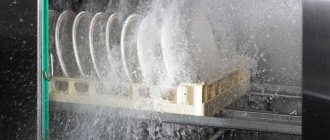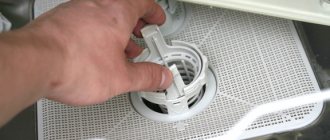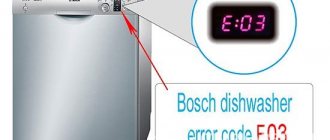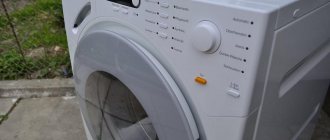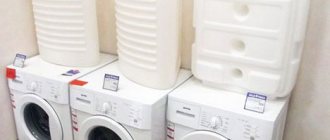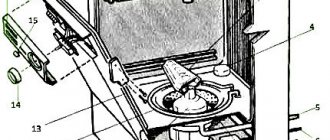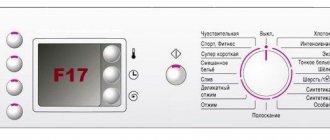What does it depend on?
If we consider the level of water consumption, according to this parameter there are 3 classes of PMM machines:
- highly economical;
- moderately economical;
- uneconomical.
For ease of understanding, each model is assigned an efficiency class, expressed in the form of letters - from “A” to “G”.
In the model range of well-known manufacturers, for example, Bosch, Candy, Electrolux, there are only highly economical PMMs, the classes of which are A - C. Uneconomical equipment is no longer produced in the EU countries, and their import is prohibited.
There is no specific standard for how much water and light a dishwasher requires.
What does consumption depend on:
- design features of the equipment;
- additional functions.
Conventionally, there are 3 classes of devices:
- household (both full-size and narrow) – 9 – 14 l;
- compact – 6.5 – 10 l;
- professional (as a rule, installed in public catering outlets with large throughput) – 20 – 25 liters.
Figures shown may vary depending on model. For example, there are dishwashers with a “half load” option, which reduces water consumption by 20 - 30%.
Another, no less useful function is “intelligent assessment”, when the equipment independently determines the required amount of liquid without compromising quality. As a rule, such functionality is inherent in premium models.
Additional ways to save resources
Additional programs provided by PMM manufacturers help save water. These include, for example, washing slightly soiled kitchen utensils. This operating mode will allow you to consume only 7 liters of liquid when fully loaded.
Not all dishwasher models have an economy mode.
There is also an economy mode that allows you to wash bowls, plates and cutlery at +50 ℃. Its fluid consumption is from 8 to 9 liters. Modern premium-class PMMs are able to independently determine the degree of loading of the working chamber and the level of contamination of the dishes. According to the obtained indicators, the temperature and water consumption rate are automatically set.
How much H2O is lost in one wash?
Water consumption directly depends on the capacity of the device.
Regular (narrow, full-size)
These are middle-class machines, where a narrow one can wash 9 sets of dishes in 1 cycle, and a full-size one can wash 10-14.
The average consumption for such equipment ranges from 9 to 14 liters . In this case, we are talking about cold water, since PMMs are often connected to cold water supply in order to save resources. That is, to wash 9 sets of dishes, the machine needs only 9 liters of water - this is quite economical.
The peculiarity is how this technique works. The PMM collects water once and uses it to wash dishes. In this case, the water passes through the cleaning filter during the cycle. Towards the end of the procedure, the technician again takes water to rinse the dishes and completes the cycle with a final rinse.
The cost-effectiveness of popular PMMs priced up to 40,000 rubles is presented in the table:
Economical
Dishwashers are produced that spend only 7 liters per cycle . Usually these are premium segment models or compact PMMs. Low water consumption does not always mean low capacity of equipment.
There are models with a large load but minimal consumption, but they are expensive. Example - Siemens SN 236100 ME, whose water consumption is 6.5 liters.
This is a full-size appliance, designed for 13 sets of dishes, with an energy consumption class of A++. As a rule, economical models require 40% less water than conventional ones.
Compact PMMs with a small capacity designed for 6 to 8 sets of dishes are also called economical. They consume the same amount of water as the narrow versions - 6.5 - 9 liters. It turns out that their level of water consumption is similar to large dishwashers, but they are capable of washing much less dishes.
Comparison with hand washing
When washing by hand, in order to wash the amount of dishes that would fit in the PMM, you will need 70 - 100 liters of water, both hot and cold.
That is, a machine with a flow rate of 7 - 14 liters requires 10 times less water.
Approximate calculation:
- Dishwasher. 14 l x 360 (days) = 5040 l (cold water);
- hand wash. 70 l x 360 = 25200 l (12000 – cold, 13200 – hot).
The price of 1 cubic meter of water depends on the region of residence. For example, a cold one costs 30 rubles, a hot one – 100.
It turns out:
- PMM. 5040 x 30 = 151.2 rubles;
- manual. 12 x 30 + 13.2 x 100 = 1680 rubles.
If you take into account water consumption, then a dishwasher is much more economical than washing by hand.
Regular dishwasher
By a regular dishwasher we will mean narrow floor-standing (9 sets) and full-size (10 - 14 sets) middle-class dishwashers. Typically, water consumption in such machines varies from 9 to 14 liters of water. And most often cold, since in most cases dishwashers are connected to a cold water supply, this is reasonable both from an economic point of view and from a safety point of view.
For your information! Hot water contains more impurities that can affect the dishwasher units.
Why is the water consumption for the washing cycle so small with so many dishes? This is explained by the operating principle of the machine. After all, having collected water, she uses it several times during washing, while the water constantly passes through the purification filter, which is important. The machine then draws in rinse water and draws in water again for the final rinse. In this case, water is sprayed under very high pressure; water passes through the rocker arms at high speed, washing the dishes. This technology does not require a large amount of water.
Here are some examples of conventional dishwashers, costing up to 40 thousand rubles, which are popular on the market. The water consumption for the washing cycle in these machines is shown in the table.
- Bosch SPV 53M00;
- Bosch SPV 58M50;
- Bosch SMS 50E02;
- Bosch SMS 40D12;
- Electrolux ESL 95201 LO;
- Hansa ZWM 606 IH.
Economical and compact dishwashers
Today, a consumption of 9 liters is not the limit for a dishwasher. Premium class machines, as well as small dishwashers, can consume no more than 7 liters of water. This is achieved thanks to certain technologies, as well as the design of the dishwasher. Reduced water consumption is reflected in its cost; usually these are premium dishwashers.
- Bosch SPV 63M50;
- Siemens SN 66M094;
- Smeg STA13XL2;
- NEFF S51M65X4;
- Smeg BLV2VE-2.
The listed models are narrow and full-size; water consumption per cycle is presented in the table. These dishwashers can truly be called economical, because water consumption is 40% lower.
Important! If the dishwasher has a half-load function, and such dishwashers probably have it, then water consumption will be reduced by another 20-30 percent, of course not by 50%, as some people think, but this is not bad. At the same time, energy consumption will also decrease, but in time the machine will work as usual.
Separately, you need to look at how much a compact or small dishwasher spends on a washing cycle. The difference in water consumption with narrow dishwashers is not great and is only 2-3 liters; some models have no difference in water consumption at all, and they can wash fewer dishes. Therefore, whether there is any savings in this or not, decide for yourself. So, we looked at how much water the following compact dishwashers waste:
- Candy CDCF 6;
- Bosch SKE 52M55;
- Siemens SC 76M522;
- Electrolux ESL 2400 RO;
- AEG F 55200 VI.
Let's celebrate! The actual water consumption of a dishwasher may differ from that stated in the passport by 1-2 liters. Does this matter much, probably not, but I would still like the information in the instructions to be accurate.
How much electricity does the PMM consume in 1 cycle?
The energy efficiency of working units and the technical solutions used by the manufacturer determine the cost-effectiveness of the PMM.
A lot of light is spent on running the heating element , circulation pump and pump.
The heating element that heats the water consumes the most; in second place is the element that ensures the drying operation. In machines without hot drying, the consumption is lower.
There are dishwashers with convection drying. They do not have a second heating element or fan, which reduces energy consumption by 40%.
For the most part, light consumption depends on the capacity of the tank containing water and its temperature. That is, a smaller tank means lower energy consumption.
Before buying a PMM, it is worth studying its energy efficiency in advance, which is indicated in the technical data sheet.
This is a line called “energy class”, where a specific letter is indicated:
- A – 0.7 – 1.7 kW;
- B – 1.08 – 1.1 kW;
- C – no more than 1.5 kW;
- D, E (nowadays they are becoming less common) – up to 2 kW;
- F, G (non-economical models) – 2.5 – 2.7 kW.
If the manufacturer was able to achieve a value below 0.7 kW, then a “+” sign is added to the figure.
Top 3 economical models
Let's consider models that allow you to save water and energy resources.
Beko DTC 36610 W
Freestanding compact model with touch controls. It can wash up to 6 sets of dishes, and consumes 6.5 liters of water per cycle . Energy efficiency class – A+.
The manufacturer has increased the safety of the equipment by installing the “WaterSafe+” system - blocking the water supply in the event of a leak.
There are all the necessary programs, for example, quick washing, working with glass, economical mode (water is heated to a temperature of +50 degrees).
The informative display will show how much time is left until the end of the cycle and display the amount of salt for washing. The only negative is that due to its compact size, the maximum number of sets of dishes is no more than 6 (for a large family this may seem small). The current price can be viewed here.
Bosch SPS 25CI07 E
Compared to the previous version, the larger and more spacious model is capable of washing 9 sets of dishes in 1 cycle , consuming the same amount of water.
This PMM is narrow, so it will not take up much free space. The GlassProtect system allows you to wash even fragile glass utensils.
The “ActiveWater” function and the loading sensor are responsible for efficiency - the machine itself will determine how much water and light it needs. Additionally, the half-load option speaks in favor of efficiency. You can program the operation of the machine in advance by setting a timer.
The cost of the machine is from 35,000 rubles.
Siemens SN 636X03 ME
Full-size equipment, protected from leaks.
Number of programs – 6. Energy consumption class – A++ (0.93 kW/h), water consumption – 9.5 l . In 1 cycle the machine can wash 14 sets of dishes.
The model can safely be called economical, since there is a half-load option and an eco mode (lowering the water temperature for not too dirty dishes). The cost of the device is from 38,000 rubles.
PMM can easily cope with heavily soiled items, for which it pre-rinses them.
Does the device save resources?
Savings make sense if meters are installed for the H2O supply . Cost-effectiveness will be considered using the example of the Siemens SN 66M094 model, designed for 14 sets of dishes.
This is 63 items, including plates, cups, pots, cutting board and cutlery. She will wash them for 3 hours (intensive mode), and will take only 10 liters of water.
If you wash at least half of these 63 items, but by hand, you will need, on average, 20 minutes and 43 liters of water (hot and cold). In terms of liquid resources, the savings are obvious.
To evaluate the real savings, you should also take into account the costs of light and cleaning tablets. It turns out that electricity is wasted, but water is saved. In general, the costs for manual and machine washing are approximately the same.
Why a dishwasher saves water and money for owners
The question of saving money is asked by many people who want to buy a kitchen assistant. They simply do not know that PMM is capable of using the same water several times, constantly purifying it. This is why a dishwasher consumes very little water per wash. In addition, the equipment is capable of using only cold water for operation, which itself heats to the required temperature (the cost of cold water according to tariffs is significantly less).
Flow-through electric water heater in the dishwasher - heating element
Even if you recalculate the cost of water taking into account the energy consumption for heating it in the PMM, it will still be cheaper than the hot liquid flowing from the tap. It is also undesirable to use the latter because it is much dirtier than cold one.
Hot tap water clogs the coarse inlet filters in the PMM with dirt much faster than cold water
Numerous comparisons of water consumption for washing dishes manually and by machine have shown that with the same number of pots, plates, cutlery and other utensils, manual work requires 10 times more liquid than when washing in a PMM! Moreover, half of the water used manually is hot.
However, you need to take into account that you won’t be able to experience the savings due to the high cost of consumables for washing in a dishwasher - detergents, rinse aids and softening salts. Future owners of dishwashers should know that the cost of washing dishes manually and automatically ends up being approximately the same.
Cost Feedback from Consumers
Users note that dishwashers are convenient for washing large dishes and kitchen utensils.
The main thing that users note is saving time , not water.
Yes, there are inconveniences associated with the need to “accumulate” dirty dishes before putting them in the washing machine.
For this reason, buying an appliance for an apartment is questionable for those people who have, for example, 2 cups and 2 plates in circulation; it is easier for them to wash the dishes by hand. But, the equipment will be a godsend for large families who like to gather with guests.
As for saving electricity, you can program your dishwasher using a timer to run at night when a reduced rate is in effect.
There is another opinion regarding the price of service. We are talking about special tablets for washing dishes. Branded consumables sometimes cost a fortune if the equipment is used frequently , but they are easily replaced with simpler and cheaper detergents.
In general, the main advantage of using a dishwasher, according to users, is saving time, the only irreplaceable resource.
Detailed reviews and discussion can be read here and here.

